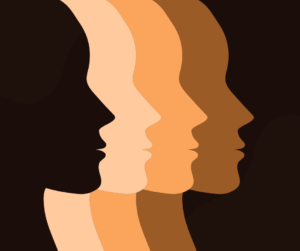In her first guest-blog post, author and communication professor-emeritus ANA K. WRENN discussed the challenges of racial colorblindness. In this continuation, she explores how the roots of racism have spread across cultures, manifesting in various ways.
Like an invasive species of toxic plant, racism spreads. Good people try chopping at those roots, wanting to eradicate it—or at least contain it. But the spreading continues, allowing racism to change textures, shapes, and hues depending on its location.
As global citizens, storytellers, and readers, we must remain aware of the variation of racism across cultures, something we’ll discuss in this post. First, though, it’s important to recognize why so much time and energy is spent on examining the roots of racism in US-America.
Enslaved peoples arrived in the American colonies in the early 17th century, arguably leaving “no aspect of the country”untouched by slavery. During the 1800s, pseudoscientific research gave rise to scientific racism in the US, further strengthening the roots of racist policies and institutions. Then, after the end of slavery, Jim Crow took over in the US-South, mandating a host of things, such as “segregation of schools, parks, libraries, drinking fountains, restrooms, buses, trains, and restaurants.” Some, including me, contend that the systems of oppression have never been completely uprooted.
Toxic roots of American racism spread globally

And while discussions of eugenics began in 19th century England, it turned into “a popular social movement” in the US where policies and programs were instituted to cut off “defective germ-plasm.” US-based eugenicists worked to promote the breeding of so-called “fit” people (e.g., whites of Northern-European descent) and cull the “unfit” (e.g., the “Jewish race,” poor, Queer, Black, persons with disabilities) from the populations. Forced sterilizations and anti-miscegenation laws (i.e., outlawing interracial marriages) were part of those efforts.
So far, this blog post has been US-centric, because it’s important to see how the toxic roots of American racism spread globally, feeding Nazi ideology and influencing Adolf Hitler, for example.
Yet, few, if any, cultures are untouched by racism given the global history of slavery, colonialism, and class/caste hierarchies. Like the US, Australia and Canada continue to struggle with legacies of having stolen indigenous children from their families, homes, and people. And in Sierra Leone and Liberia, the history of colonialism and racism played significant roles in the spread of the Ebola virus during the 2012-2016 outbreak because of the indigenous population’s distrust of foreign (largely white European and American) healthcare workers. These are only a few examples.
Then, there are the surface forms of racism, seemingly innocuous but problematically invasive too.
Lighten Up
Given the persistent messaging across cultures and time periods that white skin is better, healthier, purer, it’s no wonder that that the skin-lightening industry thrives globally, even when lightener products can be dangerous.
A multi-billion dollar industry, it “targets women of color in every region of the world. The Asian-Pacific region is the most lucrative with countries like China being one of the largest markets.
Just as colorism is rooted in racism, skin lightening (a.k.a. skin bleaching, skin whitening) is rooted in colorism, tapping into deep beliefs that “lighter skin is associated with beauty and better prospects,” such as marriage, income, education, housing, and even health.
India and Bollywood, Nigeria and Nollywood, America and Hollywood: populations worldwide wrestle with the impact of colorism, including how it centralizes certain stories and storytellers and decentralizes others. Translation: people with darker skin tones struggle to have their stories seen, told, heard, believed, and valued.
Color a better world for all
There’s pushback against colorism, though, and creatives are playing huge roles by drawing on storytelling, ultimately helping to color a better world for all.
Some celebrities in India, for example, openly discuss the damaging connection between colorism and skin lightening. Canadian-Filipino filmmaker Joanne Roberts shares her personal story to challenge shadeism. And Beverly Naya, a British-Nigerian actress, produced Skin, a documentary for Netflix Nigeria on colorism and skin lightening, topics she says we must have more conversations about.
Also, while colorism has proven resistant to eradication in Brazil, people with darker skin tones are speaking out about disparate treatment. Brazilian and Latino artists and writers are exploring the legacy of slavery and colorism.
While the toxic roots of racism have spread worldwide, how racism manifests within nations and regions will vary. Being knowledgeable of and mindful about variations will help us be better storytellers, writers, readers, and members of this human family.


0 Comment